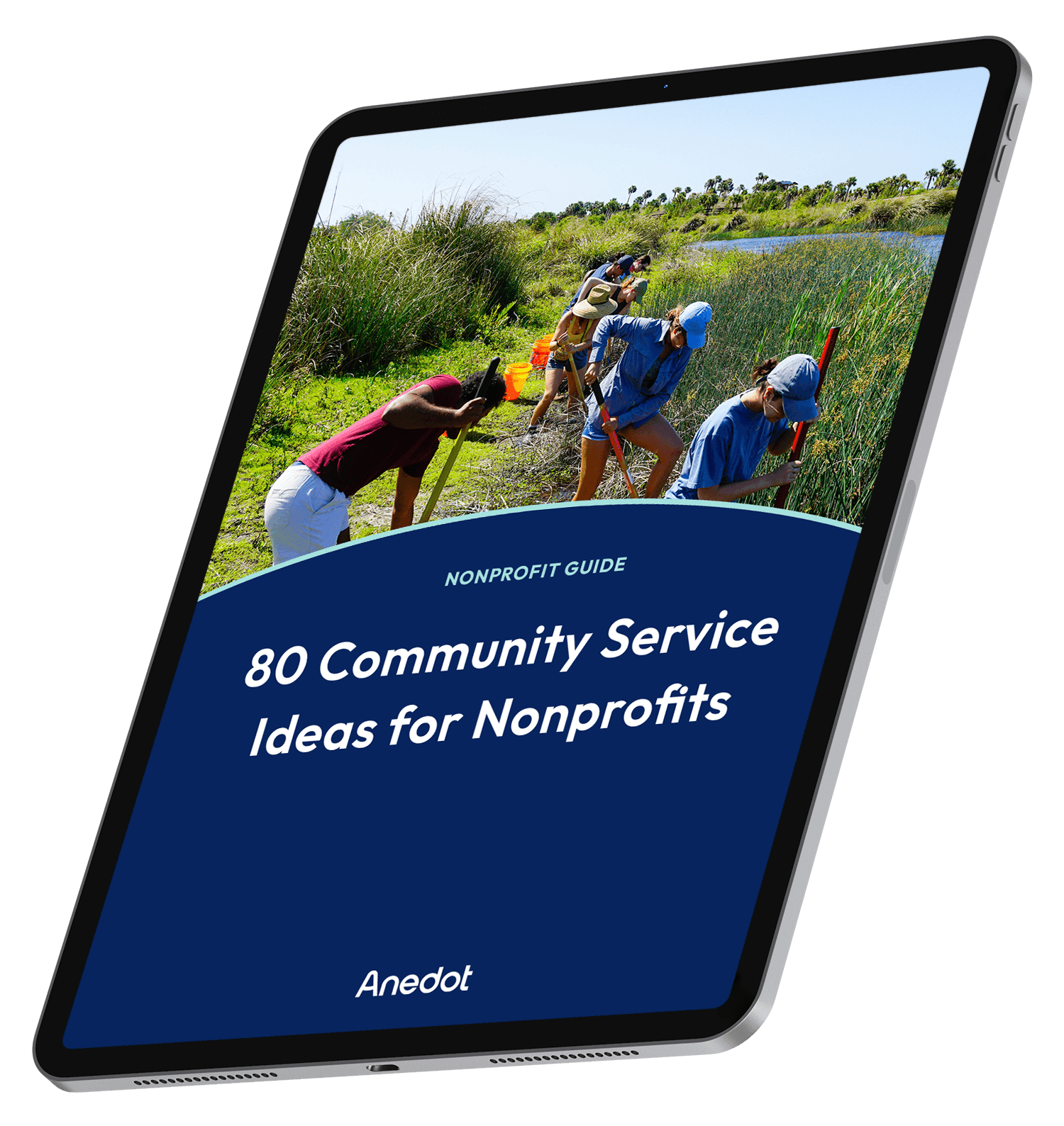Podcast episode transcript ↓
Josh:
Welcome to Big Ideas For Every Org. We help leaders discover powerful, big ideas that increase organizational impact.
I'm Josh, and today we're joined by Robert Carnes. Robert is an author, freelance writer and marketing professional.
He's led communications at multiple churches and has served Atlanta area nonprofits in marketing.
He now works as the marketing manager for GreenMellon, a digital marketing agency. Robert is the author of three books, all of them about storytelling.
Robert, thanks for joining us.
Robert:
Yeah, Josh, thank you so much for having me on.
Josh:
Hey, so before we jump into the topic today of story listening, tell us a bit about yourself and your work.
Robert:
Yeah, well you gave a nice bio for me. So I actually studied journalism when I was in college at the University of Georgia.
So I thought I was going to be a newspaper reporter, but career, as they often do, took a little bit of a different turn. So I did not expect to work in the local church or for nonprofits, but that's where I ended up.
And I was able to use my skills again, that I learned in journalism school for writing and for storytelling, was able to use those for a couple different organizations here in the Atlanta area, where I'm from.
And that's been a really interesting and fun journey for me.
So again, worked for a couple different organizations, have done freelance work as well, both as a copywriter and as a marketing consultant.
And now through a marketing agency, where I get to help a lot of different organizations to figure out their brand message and what storytelling looks like for them.
So it's been a really fun experience and I've learned a whole lot from it. And that's where writing the books has come from, is to be able to give back and share what little that I've learned along the way and help encourage organizations to tell better stories primarily.
How story listening can make an impact

Josh:
Awesome. Awesome. Well, before we talk about the solution today, and we're talking about story listening, which is a new category, I'm excited to get into it.
So tell us, how did you begin to see the problem associated with storytelling and story listening?
Robert:
Absolutely. Yeah. Storytelling, I feel like is a commonly used buzzword, like a marketing buzzword throughout pretty much every industry.
Everybody thinks they understand what nonprofit storytelling is, but many organizations don't quite practice it quite as well, or they just struggle to figure out where to begin with storytelling. It's an easy thing to talk about, and to say that you're going to do, and it's a much harder thing to actually put into practice, and do it on a consistent and regular basis and to do it well.
And so exactly like you said, I think organizations need to start listening a little bit better and that's tipping the hat a little bit at what that solution is. But so many organizations don't know where to look for stories.
They're usually default to telling stories about themselves, about their history or about what their mission is. And there's often a disconnect with that between them and their audience, who they're trying to reach.
You can reach some people that way, but you have a lot bigger impact when you make a subtle shift in the focus of your storytelling. And so just using that as kind of a jumping off point really starts to open up whole new worlds of how you can tell stories and where you can look for stories.
So that's often the problem that many organizations face to start with, but there's thankfully a pretty easy solution to at least get them going in the right direction.
Josh:
Yeah. So let's look at that. So you're helping churches, nonprofits, you're seeing the pain of storytelling within those organizations, which I have felt as well, leading communications in churches.
So tell us, how did you discover the solution of story listening to help storytelling?
Robert:
Sure. I mean, I think probably through my own failures and through struggling with it myself. I mean, like you said, it's a very common thing to try to pull that off and to try to accomplish good marketing through storytelling, but it's a much more difficult thing.
So I honestly have created this idea or maybe just stumbled across this idea of story listening more throughout my own things that I wish I would've done when I was in nonprofits, and churches and observing some of the things that other organizations have done really well.
And ultimately it boils down to, you need to put your audience as the hero of the story. That's not a new idea.
Donald Miller has talked about that quite extensively through his StoryBrand book but that's been an idea that's been around storytelling for a long time, but how to actually pull that off means that you need to spend time with your audience, means that you need to get to know them and to build empathy and trust with those people that your organization serves, and the people that are within your organization.
Because those are ultimately where the stories are coming from is the people. And so you need to actually spend time in proximity with those people.
Storytelling is not a short thing. It's not a silver bullet or a shortcut to any type of marketing.
It's a long term investment that really takes time and intentional energy into being able to build up those relationships with people, so that not only you can hear their stories, but then also you earn their trust, and they entrust you with being able to actually share those stories with a larger audience.
But ultimately it's about finding people that your audience can relate to. And the easiest way to do that is by pulling and extracting stories directly from those communities, and being able to tell stories about characters that other people can see themselves in their shoes.
They can take on that perspective and go, oh, okay, this is what this organization, or this is what this local church is doing. And this is how it impacts me directly. And all of that is tied up with story listening.
How to implement the story cycle

Josh:
That's great. So tell us if you are a nonprofit leader, a higher education leader, a church leader, what's the process of implementing this in their orgs?
Robert:
Yeah, that's a great question.
And that's essentially the framework of the book that I put together that is coming out next month that I call The Story Cycle and it all begins with story listening, but then you also need to capture that story, to write it down somewhere in a place that your organization can actually find it later.
That's the kind of boring administrative work of storytelling. We often like to think of it as very creative and it absolutely is, but there also needs to be a very detailed and organized approach to it as well.
And that also involves editing and crafting the stories in a way that they're actually going to connect with your audience. And we have to do all of that prep work before we're then able to actually share a story.
The telling piece of this storytelling puzzle is often what attracts our attention. That's the piece we focus on. But there's a whole lot more that comes before that to make a story impactful and to make it something that's going to resonate with your audience.
And then we often forget about what it means after an audience hears a story, but that's the second half of The Story Cycle is actually how an audience experiences that story, whether or not they take action on that story, because I feel like every organizational story should have some sort of next step attached to it.
There should be some very clear action that your audience should take with it. And then hopefully if that gets them involved with your organization, and with your church, or even a business, hopefully that impacts them for the better.
And then that creates another opportunity for a story to be told because you've generated another kind of life change or transformation in another person that's hopefully a story being worth told.
So that's essentially a rough framework of, again, what I like to call The Story Cycle, which I outline in completion in the book that I wrote with that same title.
Josh:
So what are some of the challenges associated with doing this in an organization.
I've led communications marketing, I've helped numerous organizations, businesses, nonprofits, mission driven orgs clarify their messaging and their marketing.
What are some of the challenges, and I know them well, that you've seen in trying to implement this?
Robert:
Yeah, absolutely. Well, I mean, think again in The Story Cycle, I talk about that there is a misstep that you can take along the way during each of those different stages, that'll kind of break the cycle and that it'll prevent it from reaching the right audience, or prevent the audience from taking the correct action, or from making the action not kind of resonate with them or be meaningful.
So, I mean, usually that begins with story listening because every organization, as long as you're involved with people, there are stories to be told.
But so often that first kind of mistake or challenge that organizations face is just neglecting to actually listen, neglecting to build those relationships with people.
And so there's often so many stories, great stories, inspirational stories that get missed, and don't have the opportunity to be shared simply because we're not slowing down enough to again, build those relationships, to build empathy with who we're trying to serve, and missing the stories that would really both impact that individual because they feel seen, because we've gotten to know them, we've shared their story.
But then missing out on the potential of connecting with other people because that story, again, they'd never heard that story or that didn't connect with them.
So there are many challenges that come along the way, but oftentimes it begins with that failure to prioritize listening.
The positive effects of story listening

Josh:
So looking back now, looking at organizations who have implemented or at least began to implement a story listening, intentional story listening at the front of their storytelling efforts, what are the positive effects and results from implementing this?
Robert:
Yeah, I mean, think obviously it very clearly and immediately helps you tell better stories.
I mean, I think that's the short side effect and the easy thing to see, but I think when we do this well and we really prioritize it and do it intentionally, it's going to help us to create better organizations.
It's going to help our nonprofit serve more people. It's going to help our church keep our community and the people who are in need at the focus and the front of our minds.
And so because the side effect is when we're listening to people, when we have those relationships and we're doing all that we can to maintain them, and we're able to use those narratives to connect with more people, and we grow in steady and healthy ways, we have better organizations.
We're able to do a better job of fulfilling the mission that we're setting out to do. And it's because that storytelling practice, that story listening practice helps us to keep the right priorities, to build empathy with people, to keep relationships at the forefront.
I mean, it's a mutually beneficial thing, it's a positive upward cycle, all because better organizations tell better stories and better stories help to build better organizations.
Josh:
That's awesome.
So what would you say to those who are on the fence, those who may have some pushback to modifying how they're doing storytelling, what their process looks like, what would you say to those people?
Robert:
I think because storytelling is such an integrated part of who we are as a culture, it's at our core as human beings, we are storytelling animals. So I don't think most people need convincing that stories are real or that they are impactful.
I mean, there's so many statistics that a lot of influencers throw around about how we are engaged so much more with a narrative versus just raw data or information. It really is a very powerful communications vehicle.
So that's usually not the struggle. The struggle is, yeah, how do we convince leaders to take the time to invest in storytelling? Because again, we can default to telling stories about ourselves. Those are the quicker and easier things to do. Those are the most visible stories to us.
So yeah, the real challenge for getting organizations and leaders to adopting this slightly changed mentality is investing the time, investing the resources and knowing that we may not see the return on investment for a little while, that it's going to kind of be the long term game.
But ultimately, I mean, this is just the better way to do it. This is the more effective way to tell stories.
This is going to be the way that you're going to be able to scale storytelling over the long term. It's going to be the way that it's going to consistently land with your audience.
It's going to continue to connect with people over the long term because otherwise the stories you're telling, they're just going to continually sort of miss with people. You may be able to hit on one that resonates with somebody, but then you're going to have one that's a little bit more of a miss.
So I think if any organization really wants to consistently tell effective stories and to be able to build it up in just a scalable and a consistent way, that's organized, and is going to be able to, again, just to connect with your audience on a deeper level, on a more relational level, I think this is the subtle change that we have to make.
And more of a mindset shift, more than anything else that's going to help to make the right processes to go in place. So hopefully that's the thing.
And ultimately, that's the thing that most organizations who do storytelling well, that's what they do.
Whether they recognize it or not, those are the practices that really make them effective and really put them at the forefront of marketing and organizational storytelling.
Closing thoughts

Josh:
Robert, I can't wait to read your book. We were talking before the show here, just talking about story listening.
And right when you said that and you brought it up, it hit me because I've been responsible for collecting stories at an organization, and telling those stories, and the listening part is such a missing, but important piece of the storytelling practice.
And so I can't wait to read your book.
I hope others do as well. Where can our listeners find out more about you and your work?
Robert:
Yeah, absolutely.
So you can follow me on social media. I'm active on Twitter and on LinkedIn at jamrobcar. or
But if you want to learn more about the book and see who I am as an author, and again, learn a little bit more about this whole idea of The Story Cycle and story listening, you can go to storycyclebook.com and you can learn more about it there.
And the book actually releases in October of this year, 2022.
So I encourage anybody to check it out and hopefully it's a resource that's really beneficial to you and your organization.
Josh:
Awesome. Robert, thanks so much for coming on.
Robert:
Yeah, Josh, thanks so much for having me.
This was a great conversation.
Josh:
Hey, thanks for listening.
If you enjoyed this episode, please share it with others or leave us a rating and review.
To read show notes and resources mentioned in this episode, visit anedot.com/bigideas.
Again, that's A-N-E-D-O-T.com/bigideas.
We'll see you next time.

80 Community Service Ideas for Nonprofits





















